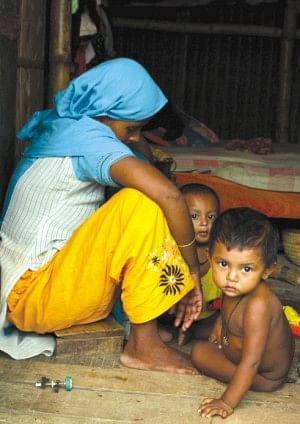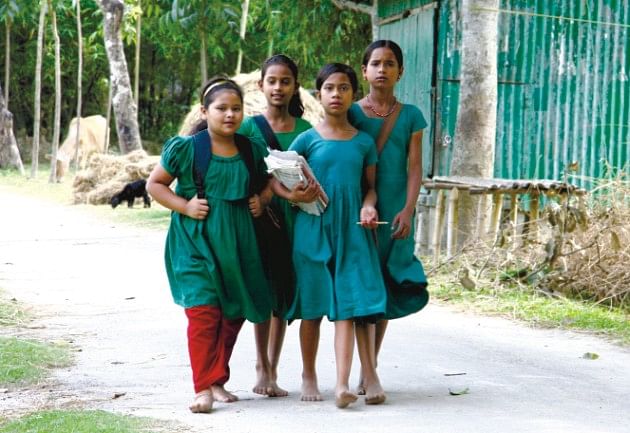| Endeavour
The Challenge of Meeting the Targets
Farhana Urmee
 |
The main challenge is the reality of child marriage and teenage pregnancy. Photo Zahedul i khan |
The August 24 issue of a leading Bangla newspaper carried the story. A nine-month-pregnant woman died after she jumped off a foot-over-bridge in Savar. The woman, reported to be so destitute that she could not bear the expenses associated with her delivery finally gave birth to a child after she jumped off.
The mother and the child died on the spot.
Quoting patients of Savar Upazila Health Complex the report mentioned that the woman had gone there and pleaded doctors to let her get admitted. But the doctors referred her to Dhaka Medical College and Hospital when the woman was already in labour. The woman did not even have the money to bear expenses at Savar and she roamed around aimlessly near the Savar bus stand until she decided that death was the only escape from the unbearable pain.
Less than a month into the incident Bangladesh received a Millennium Development Goals (MDGs) award for attaining significant success in bringing down the rate of child mortality. Experts doubted the success adding that the first thing is to be considered here is to know how the government is claiming the reduction and making the estimate. Experts emphasized the necessity for amending the indicators taken into count to measure success in attaining MDG goals.
Reduction of child mortality is the fourth point of the set of eight MDGs. The third point is gender parity and women's empowerment, which can be taken as an example of partial estimation of success. Women's rights activist Faisal Bin Majid, coordinator Nari Pragati Shangha, says that the enrolment of girls in schools cannot be the final indicator to know about the status of girls' education as there are huge dropouts of girls in schools.
He also mentioned that the indicator for women's employment is also inadequate. He cited that women working in the agriculture sector are not recognised for their labour while the recognised sectors are giving very low wages to women. “To ensure gender parity and women empowerment women labour in agriculture must be recognized and wage must be equal for both men and women,” says Faisal.“The MDG-3 is definitely going to be achieved by 2015 if indicators remain the same. But the actual picture would be totally different with a huge number of girls who dropped out still remaining uneducated and women deprived of equal wage,” he adds.
The main obstacle to women's empowerment and gender parity is the national women policy which is yet to allow equal property rights to women. Successive governments have been enjoying significant media coverage by claiming that the policy, once established, will address all these issues.
With five years left to meet the goals of the Millennium Development Goals (MDGs), a set of eight commitments among 189 countries, the possibility of attaining all the goals within the time-frame of 2015 might seem easier when the reality is that the destitute are out of the reach of health service and women are still very much victims of gender disparity. The other goals that the head of 189 countries agreed on are poverty eradication; universal primary education; improving maternal health; combating HIV/Aids/Malaria and other diseases, ensuring environmental sustainability and developing global partnership for development.
Bangladesh Progress Report 2009- on the Millennium Development Goals (MDGs), prepared by the Planning Commission, states a number of challenges still ahead to be won to attain MDG four- to improve maternal health. The main challenge in this regard is the reality of child marriage and teenage pregnancy. According to UNICEF World Child Report 2009, 64 percent girls are married before their 18th birthday in the country while 60 percent of them become pregnant before 19.

The enrolment of girls in schools cannot be the final indicator to know about the status of girls' education as there are huge dropouts of girls in schools. Photo Zahedul i khan
However, the maternal mortality rate has declined by 40 percent during the period between 1995 and 2005.The rate of such deaths remained stable and the rate remains 350 per 100,000 in the following four years. Yet a number of challenges have to be taken into account in order to improve the state of maternal health. The other challenges the Planning Commission report has identified are inadequate coordination between family planning and health care services, improper skill mix, and insufficient health work force and improper sector planning, inadequate government funding and underlying socio-cultural constraint.
However, child mortality rate reduced since 1990 with regards to both child under-five-years of age and infant. Measles immunization coverage which was 54 percent in 1991 has increased to 84 percent in 2009.
Against this backdrop, Prime Minister Sheikh Hasina recently in the opening day of a three-day high-level plenary meeting of the United Nation's General Assembly said the country would require 4.4 billion US dollars a year to reach the MDG target by the committed deadline. According to her estimate, 22.1 billion US dollars can ensure meeting of all the MDG goals by 2015. Bangladesh's progress in the MDG 1, 2, 3, 4 (poverty alleviation, universal primary education, gender parity and reduction of child mortality) was highlighted at the Assembly as the country is well on course in achieving the targets.
The Government's safety net programmers, budgetary allocation for poor, old, disabled might help to alleviate poverty by 2015 as the poverty level has already come down from 60 percent in 1990-91 to 37 percent, the planning commission says in its report. The report, however, states that meeting the target of hunger within the given timeframe remains uncertain and increasing inequality among people of the country is the main problem in this case.
"The rate of economic growth is satisfactory in last few years, but a few people are getting it's benefit. A good number of poor people are remaining poor. Some people also run the risk of getting poor due to disaster and accidents. The Government is going to give a huge effort to eradicate the poverty and hunger within 2015", says economist Dr Quazi Kholiquzzaman Ahmad.
The government's recently formulated new education policy can help to attain the goal of universal education by 2015, although there are still questions regarding the indicators of measuring the successes. The Planning Commission Report lauded Bangladesh's position in MDG-6 (combating HIV/AIDS, malaria and other diseases) as HIV incidence in the country is still low (0.1%) and trends show a decline of Malaria cases as well. And regarding MDG-7 (environmental sustainability) and MDG-8 (global partnership for development) the report states that the country cannot do anything alone; help from developed countries along with our neighboring countries is needed.
“Some of the goals might be achieved while some others will require huge effort. Success of the programme does not lie only in achieving the goals by the deadline but also in making sure that the changes it is bringing sustains in the society,” says Dr Ahmad.
Copyright
(R) thedailystar.net 2010 |
